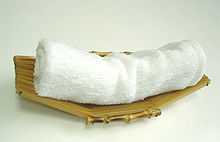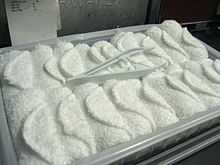Oshibori

An o-shibori (おしぼり or お絞り[1]) or hot towel in English is a wet hand towel offered to customers in places such as restaurants or bars in China and Japan and in some Chinese and many Japanese restaurants worldwide. O-shibori are used to clean one's hands before eating, and have long been a common sight in China and Japan. Cold oshibori are used in summer, and hot oshibori in winter. In mājan parlors, the words atsushibo and tsumeshibo, from the Japanese words atsui (熱い), hot, and tsumetai (冷たい), cold, are sometimes used to refer to hot and cold o-shibori respectively.
Derivation of word
The word o-shibori comes from the Japanese word shiboru (絞る), meaning "to wring", with the honorific prefix o-, which is added to several types of nouns, including many nouns related to washing or food; o-nigiri/o-musubi (お握り and お結び) "rice ball" follows the same pattern – see honorific prefix usage. In Japanese script, the word o-shibori is normally written in hiragana (おしぼり), seldom using kanji (お絞り or 御絞り).
O-shibori are also known as o-tefuki; tefuki refers to ordinary handkerchiefs, and these derive from the Japanese te (手) (hand) and fuku (拭く), to wipe.
Typical o-shibori

A typical o-shibori, made of cloth, is dampened with water and wrung. It is then placed on the dining table for customers to wipe their hands before or during the meal. The o-shibori is often rolled or folded and given to the customer on some kind of tray. Even if a tray is not used, it is usually rolled up into a long, thin shape, although this is not necessarily the case with o-shibori provided with, say, bentō lunch boxes.
Many establishments also give out towels made of non-woven cloth or paper, which are generally used once and then disposed of. Paper ones sometimes contain a sterilizing agent such as alcohol or stabilized chlorine dioxide. Paper o-shibori, unlike cloth o-shibori, can be folded and put into a very thin plastic wrapping, for inclusion with packaged products such as bentō lunch boxes in convenience stores.
Hot and cold o-shibori
An o-shibori can be moistened with hot water at an appropriate temperature or steam to make a hot o-shibori, or placed damp into a refrigerator to make a cold o-shibori suitable for use in summer. Sometimes in Europe it is more commonly known as Hot Towel. Restaurants usually use an electric appliance such as a heating cabinet or refrigerator for this. The heated towel used in barber's shops to moisturize the skin or beard and make it easier to shave can also be thought of as a type of o-shibori.
Rented o-shibori
As many establishments use o-shibori in large quantities, they often do not prepare them in the store, but instead employ a rental service which launders them, rolls them into the typical cylindrical shape, and delivers them already damp. These rental service companies services frequently wrap each o-shibori individually in a clear, lightweight plastic seal (polyethylene film), which can be easily broken and removed by the customer before using.
O-shibori dispenser
Now some beauty salons and dental clinics prefer to use a standalone o-shibori dispenser, with which a freshly made towel is manufactured at the client's request. In this case, the towels are often made of a nonwoven fiber.
Around the world
O-shibori is called "hot towel" in the United States. Most airlines distribute hot towels to international first and business class passengers prior to the first meal on long haul flights.
References
- ↑ Kenkyusha's New Japanese-English Dictionary, ISBN 4-7674-2015-6
Related links
Sources
Much of this article was translated from the equivalent article in the Japanese Wikipedia, as retrieved on November 26, 2006.